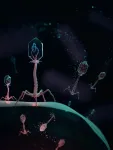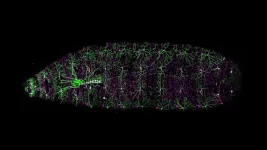(Press-News.org) BOSTON – A new targeted drug has not only sparked remissions in patients with a common form of leukemia but also induced the cancer cells to reveal one of their schemes for resisting the drug, investigators at Dana-Farber Cancer Institute and other research centers report in a new pair of studies in the journal Nature.
One of the papers presents results of a clinical trial in which approximately 40% of patients with acute leukemia subtypes had a complete response – a disappearance of all signs of cancer – to treatment with the drug revumenib. The other paper uncovers a molecular countermove by which leukemia cells come to sidestep the drug and reassert their growth.
The papers point to the promise of the targeted approach to acute leukemia treatment exemplified by revumenib and to the potential to extend its benefits with drugs that trip up the resistance mechanism, researchers say.
"The two genetic subtypes of acute leukemia involved in this research account for approximately 40% of all cases of acute myeloid leukemia (AML) in children and adults," says Scott Armstrong, MD, PhD, president of the Dana-Farber/Boston Children's Cancer and Blood Disorders Center and co-senior author of the paper on revumenib resistance. "They're driven by a rearrangement of the MLL1 gene or a mutation in the NPM1 gene. Both types depend on a protein called menin to sustain their growth."
The first of the new Nature studies reports on a phase I/II clinical trial of the drug revumenib, which targets menin, in 68 patients with acute leukemia that wasn't responding other therapies. The trial, dubbed the AUGMENT-101 study, found that of 60 patients who could be evaluated, 53% responded to the drug and 30% had a complete response.
"For patients with acute leukemia who have undergone several previous treatments, this is a very encouraging result," Armstrong says. "However, after the second cycle of treatment, some patients did develop resistance to revumenib."
In their follow-up study, Armstrong and his associates sought a source of that resistance.
Menin is a critical part of the cell's "epigenetic" mechanism for switching gene activity on and off. It binds to chromatin – the braid of DNA and protein packaging within the nucleus – and summons large protein complexes to join it. The complexes tighten or loosen the coils of DNA, changing the activity level of the genes at that site. One of the key proteins within these complexes is MLL1, the product of the MLL1 gene.
"Revumenib contains a small molecule that inhibits the interaction of menin and MLL1," Armstrong says. "The AUGMENT trial shows it can produce remissions in a high percentage of patients."
When Armstrong and his colleagues analyzed bone marrow samples from some of the patients who became resistant to revumenib, they found that many had developed mutations in MEN1, the gene that gives rise to the menin protein. The mutation leads to a deformed version of menin that doesn't bind well to revumenib but attaches as firmly as ever to MLL1. As menin and MLL1 renew their interaction, leukemia cell growth restarts.
The finding provides "formal proof in patients that menin itself is a valid target for therapy in both genetic subtypes of AML," Armstrong relates.
In a sense, revumenib acts as a kind of truth-telling serum on leukemia cells: by placing the cells under pressure, it prompts them to divulge one of their strategies for survival. "The fact that the cell has gone through so much trouble to mutate MEN1 in order to survive is a strong indication that we're hitting a target the cell truly relies on," Armstrong states.
The ability of revumenib to stress leukemia cells to the point where they develop a mutation to remain alive is testament to the drug's effectiveness, he continues. "This is the first time a drug targeting a chromatin-binding protein complex has been shown to put that degree of pressure on cancer in a human patient."
By tracking the development of mutations in MEN1 and other genes in patients with acute leukemia, doctors may be able to identify patients at high risk of relapsing, Armstrong relates. Such patients might then benefit from further treatment. The discovery of MEN1 mutation as a resistance mechanism suggests that new drugs that specifically target menin or other chromatin-associated proteins could prevent or delay revumenib resistance or treat patients who have become resistant to the drug.
“Seeing Dr. Armstrong’s work translated elegantly into the clinic where patients – including some at Dana-Farber, who had dramatic responses in dire situations – was highly gratifying personally and professionally," says Dana-Farber's Richard Stone, MD, a co-author of both Nature studies. "We are now ready to magnify the impact of these results by conducting clinical trials combining revumenib with standard chemotherapy as well as with novel agents, also based on preclinical work done in great part by Dr. Armstrong.”
The co-senior authors of the MEN1 mutation paper are Ross L. Levine, MD, and Sheng F. Cai, MD, PhD, of Memorial Sloan Kettering Cancer Center. The co-first authors are Florian Perner, MD, PhD, of Dana-Farber, Boston Children's Hospital, and Greifswald University Medical Center, Greifswald, Germany, and Eytan M. Stein, MD, of Memorial Sloan Kettering. Co-authors are: Daniela V. Wenge, MD, Athina Apazidis, Homa Rahnamoun, PhD, Christian Marinaccio, PhD, Charlie Hatton, Yanhe Wen, Elizabeth Ener, Jevon A. Cutler, PhD, Jeonghyeon Kim, PharmD, of Dana-Farber, Boston Children's Hospital, and Harvard Medical School; Richard M. Stone, MD, Radosław P. Nowak, PhD, and Eric S. Fischer, PhD, of Dana-Farber and Harvard Medical School; Disha Anand, PhD, of Dana-Farber and Greifswald University Medical Center; Sukrit Singh, PhD, Holly A. Gamlen, Wenbin Xiao, MD, Aaron J. Stonestrom, MD, PhD, Shoron Mowla, Sonali Persaud, and John D. Chodera, PhD, of Memorial Sloan Kettering; David Schaller, and Andrea Volkamer, PhD, of Institute of Physiology, Charité-Universitätsmedizin Berlin, Berlin, Germany; John G. Doench, PhD, of the Broad Institute of MIT and Harvard; and Gerard McGeehan, PhD, of Syndax Pharmaceuticals, Waltham, Mass.
Acknowledgements
This research was funded in part through the NIH/NCI Cancer Center support grant P30 CA008748. Additional support was provided by the American Society of Hematology; the Mark Foundation for Cancer Research; National Cancer Institute grants K08 CA241371-01A1, R35 CA197594, K08CA267058, and R01 CA173636; National Institute of Health grants CA176745, CA206963, CA204639, CA214608, CA066996, F32CA250240-02, and R01 GM121505; a SPORE grant in myeloid malignancies (P50CA206963); a Cycle For Survival Innovation grant; a Samuel Waxman Cancer Research Foundation grant; the Leukemia and Lymphoma Society; Alex’s Lemonade Stand Foundation; the German Research Foundation (grant DFG; PE 3217/1-1); the ‘Else Kröner-Fresenius-Stiftung’ (2021-EKEA.111); the Stiftung Charité; the BIH Einstein Foundation; Bayer; the Runx1 Research Program; a Cycle for Survival’s Equinox Innovation Award in Rare Cancers; the MSK Leukemia SPORE Career Enhancement Program; and the Damon Runyon Cancer Research Foundation.
About Dana-Farber Cancer Institute
Dana-Farber Cancer Institute is one of the world’s leading centers of cancer research and treatment. Dana-Farber’s mission is to reduce the burden of cancer through scientific inquiry, clinical care, education, community engagement, and advocacy. Dana-Farber is a federally designated Comprehensive Cancer Center and a teaching affiliate of Harvard Medical School.
We provide the latest treatments in cancer for adults through Dana-Farber Brigham Cancer Center and for children through Dana-Farber/Boston Children’s Cancer and Blood Disorders Center. Dana-Farber is the only hospital nationwide with a top 5 U.S. News & World Report Best Cancer Hospital ranking in both adult and pediatric care.
As a global leader in oncology, Dana-Farber is dedicated to a unique and equal balance between cancer research and care, translating the results of discovery into new treatments for patients locally and around the world, offering more than 1,100 clinical trials.
END
Study unravels a cause of resistance to novel drug in patients with acute leukemia
2023-03-15
ELSE PRESS RELEASES FROM THIS DATE:
Making sense of scents: Deciphering our sense of smell
2023-03-15
Breaking a longstanding impasse in our understanding of olfaction, scientists at UC San Francisco (UCSF) have created the first molecular-level, 3D picture of how an odor molecule activates a human odorant receptor, a crucial step in deciphering the sense of smell.
The findings, appearing online March 15, 2023, in Nature, are poised to reignite interest in the science of smell with implications for fragrances, food science, and beyond. Odorant receptors - proteins that bind odor molecules on the surface of olfactory cells - make up half of the largest, most diverse family of receptors in our bodies; A deeper understanding of them paves the way for ...
Scientists discover key information about the function of mitochondria in cancer cells
2023-03-15
Scientists have long known that mitochondria, the "powerhouses" of cells, play a crucial role in the metabolism and energy production of cancer cells. However, until now, little was known about the relationship between the structural organization of mitochondrial networks and their functional bioenergetic activity at the level of whole tumors.
In a new study, published in Nature, researchers from the UCLA Jonsson Comprehensive Cancer Center used positron emission tomography (PET) in combination ...
Artificial Sweetener could dampen immune response to disease in mice
2023-03-15
Francis Crick Institute press release
Under strict embargo: 16:00hrs GMT Wednesday, March 15, 2023
Peer reviewed
Experimental study
Animals / Cells
Artificial Sweetener could dampen immune response to disease in mice
Scientists at the Francis Crick Institute have found that high consumption of a common artificial sweetener, sucralose, lowers activation of T-cells, an important component of the immune system, in mice.
If found to have similar effects in humans, one day it could be used therapeutically to help dampen T-cell responses. For example, in patients with autoimmune diseases who ...
New research shows recovering tropical forests offset just one quarter of carbon emissions from new tropical deforestation and forest degradation
2023-03-15
A pioneering global study has found deforestation and forests lost or damaged due to human and environmental change, such as fire and logging, are fast outstripping current rates of forest regrowth.
Tropical forests are vital ecosystems in the fight against both climate and ecological emergencies. The research, published today in Nature and led by the University of Bristol, highlights the carbon storage potential and the current limits of forest regrowth to addressing such crises.
The findings showed degraded forests recovering from human disturbances, and secondary forests regrowing ...
Targeting menin induces responses in acute leukemias with KMT2A rearrangements or NPM1 mutations
2023-03-15
Researchers from The University of Texas MD Anderson Cancer Center showed that inhibiting menin with revumenib, previously known as SNDX-5613, yielded encouraging responses for advanced acute leukemias with KMT2A rearrangements or mutant NPM1. Findings from the Phase I AUGMENT-101 trial were published today in Nature.
The overall response rate among 60 patients was 53%, and the rate of complete remission or complete remission with partial hematologic recovery was 30%, with 78% of patients achieving clearance of measurable residual disease. Responses were seen across multiple dose ...
Bird flu associated with hundreds of seal deaths in New England in 2022, Tufts researchers find
2023-03-15
Researchers at Cummings School of Veterinary Medicine at Tufts University found that an outbreak of highly pathogenic avian influenza (HPAI) was associated with the deaths of more than 330 New England harbor and gray seals along the North Atlantic coast in June and July 2022, and the outbreak was connected to a wave of avian influenza in birds in the region.
The study was published on March 15 in the journal Emerging Infectious Disease.
HPAI is more commonly known as bird flu, and the H5N1 strain has been responsible for about 60 million poultry ...
Designing more useful bacteria
2023-03-15
In a step forward for genetic engineering and synthetic biology, researchers have modified a strain of Escherichia coli bacteria to be immune to natural viral infections while also minimizing the potential for the bacteria or their modified genes to escape into the wild.
The work promises to reduce the threats of viral contamination when harnessing bacteria to produce medicines such as insulin as well as other useful substances, such as biofuels. Currently, viruses that infect vats of bacteria can halt production, compromise ...
New laser technology developed by EPFL and IBM
2023-03-15
Scientists at EPFL and IBM have developed a new type of laser that could have a significant impact on optical ranging technology. The laser is based on a material called lithium niobate, often used in the field of optical modulators, which controls the frequency or intensity of light that is transmitted through a device.
Lithium niobate is particularly useful because it can handle a lot of optical power and has a high “Pockels coefficient”, which means that it can change its optical properties when an electric field is applied to it.
The researchers achieved their breakthrough by combining ...
How genome doubling helps cancer develop
2023-03-15
A single cell contains 2-3 meters of DNA, meaning that the only way to store it is to package it into tight coils. The solution is chromatin: a complex of DNA wrapped around proteins called histones. In the 3D space, this complex is progressively folded into a multi-layered organization composed of loops, domains, and compartments, which makes up what we know as chromosomes. The organization of chromatin is closely linked to gene expression and the cell’s proper function, so any problems in chromatin structure can have detrimental effects, including the development of cancer.
A common event in around 30% of all human cancers is “whole genome doubling” ...
Magnificent wiring
2023-03-15
NEW YORK – For a functioning brain to develop from its embryonic beginnings, so much has to happen and go exactly right with exquisite precision, according to a just-so sequence in space and time. It’s like starting with a brick that somehow replicates and differentiates into a hundred types of building materials that also replicate, while simultaneously self-assembling into a handsome skyscraper replete with functioning thermal, plumbing, security and electrical systems.
The accompanying microscope image, from ...




